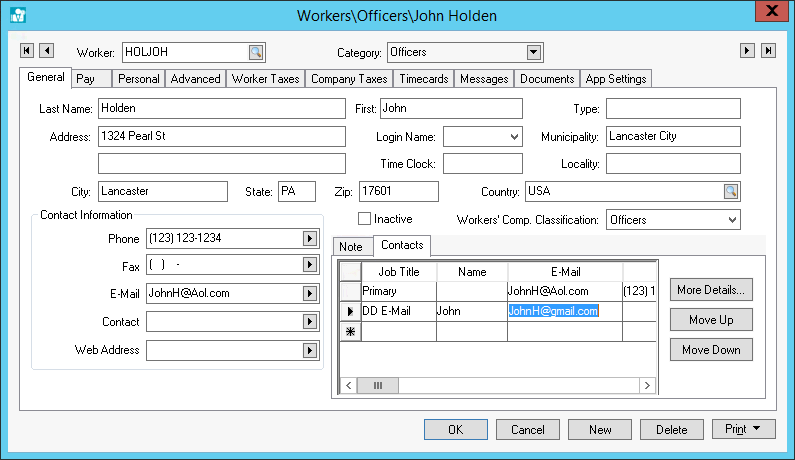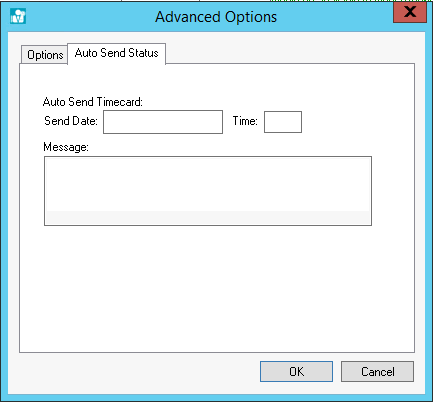Select File > Auto Send
Options > Auto Send Modes from the main EBMS menu to open
the following list:
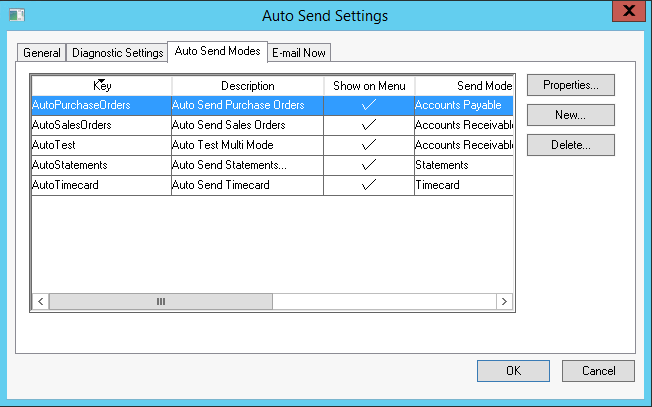
Click the New button
to create a new Auto Send Mode
and open the following dialog or select an Accounts Receivable Auto Send Mode and click the Properties button. Continue with
step 6 if the mode has already been created:
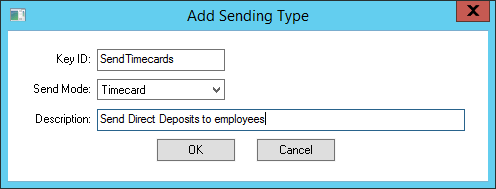
Each Auto Send Mode requires a unique Key ID. This Key ID should be a simple descriptive code that does not include spaces or symbols.
Select the Timecard Send Mode option as shown above.
Enter a short Description of the auto send mode type. This description should clearly describe the mode process. Note that this text is used as the EBMS menu label. Click OK to continue.
Configure the Send Mode Properties
as shown below:
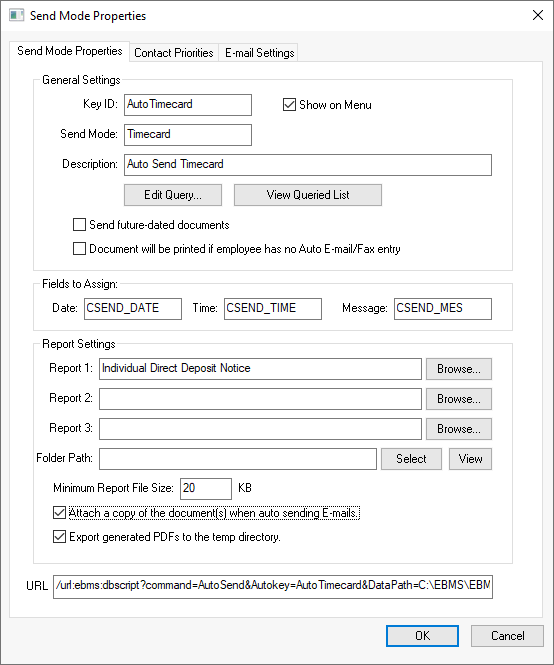
Enable the Show on Menu option to display the Timecard Auto Send mode on the menu and enable the batch mode. Disable this option if the Auto Send process is scheduled using the Task Scheduler App.
Click on the Edit Query button to select the group of timecards to be sent as shown below:

The query example shown above will send Direct Deposit Notices for all paid Timecards with a payment method of Direct Deposit. Review the [Main] Getting Started > Technical > Set Query Options section of the Main documentation for more details on creating query expressions. Click the OK button to save.Click the View Queried List to view all timecards that will be sent based on the current query setting as shown below:
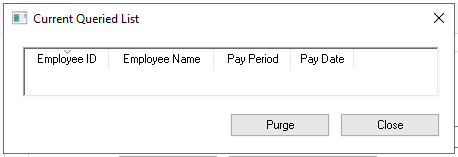
The Current Queried List lists all timecards that match the query and have not been previously sent. The Send Date within the timecard must be blank. Click the Purge button to populate the Send Date for all timecards listed, removing them from a query. A purge is often required when a new query is created. Click the Close button.Maintain the default values within the Fields to Assign settings since they are advanced settings.
Enter the INDIVIDUAL DIRECT DEPOSIT NOTICE Report. This Report is specifically designed to use with Auto Send. PDF reports generated with this mode will be encrypted; they can be opened using the last four digits of the worker's social security number. Contact your EBMS consultant for information on custom reports needed for this process. Click Advanced to configure the exported PDF Attachment Name.
Review [Sales] CRM > Auto Send > Auto Send Additional Documents to include other reports to this E-mail.
The Minimum Report File Size setting: This feature allows you to stop any sends on export files that are below a certain file size. This value should be set at about 10K less than the average exported PDF file size to prohibit blank reports to be sent as an attachment. Please contact EBMS support for suggested values on this advanced setting.
Enable the Attach a copy of the document when auto sending E-mails option to attach a PDF file that is formatted for the worker to print. Note that no files will be attached if this option is disabled.
Enable the Export generated PDF's to the temp directory option to record a copy of the document to the temporary directory instead of the shared Export Folder identified in the Auto Send Settings > General tab. For security purposes, it is encouraged to use Export generated PDFs to the temp directory for this mode. After the batch is sent, all generated PDFs are deleted from the computer sending the batch.
Complete one of the following methods to launch the process to auto send a batch of sales orders or invoices:
By selecting Labor > Send Direct Deposits to Workers from the main EBMS menu if the Show on menu is enabled.
Using the Task Scheduler App: Use the URL text located at the bottom of this dialog to configure the Task Scheduler App. Review [Main] Technical > Automate using Task Scheduler App for instructions to send receipts on a weekly basis.
Click on the Contract Priorities
tab as shown below:

The Auto Send option within
EBMS gives the user multiple options to send a document. The Contact Priorities are used to prioritize
the send options. The priority order is top-down. In the above dialog,
E-mail will be preferred, with Fax being used when there is no Auto
E-mail entry in the worker's contact list. Complete the following
steps to create and order the send options:
Select a send type option as listed below:
E-mail: This is the most common send type.
CC E-mail: This option will send a carbon copy of the email. This send type can be listed anywhere in the priority list in order to be utilized. The CC E-mail will always be sent if the E-mail send type is priority.
Fax: This refers both to faxes (through a modem or fax printer) and email-to-fax sends.
Select a Contact Type for each send type. The Contact Type is set within the General tab of the worker record. Review [Sales] CRM > Contact Management for more details on changing worker contact labels.
Select the Advanced tab to set the PDF Attachment
Name created by the reports configured in the Send
Mode Properties. User defined file names can be
set for each of the corresponding reports set in the main property
tab described previously in this section.

Click on the E-mail Settings tab as shown below:

The E-mail Settings determine the details of the email document that
will be automatically sent.
The recommended From Address is to match the From Address entered within the . Customer replies will be sent to this e-mail.
Use the BCC Address to send a copy of all emails to the Worker/department responsible for sending out the Direct Deposit slips so that they can verify that they are going out satisfactorily.
Enter an appropriate Subject line for the email broadcast.
Enter the appropriate Body Text using HTML or plain text syntax. The keywords list located at the bottom of the dialog can be used within the email body. Note that line break tags (<br />) may cause extra lines in the email.
